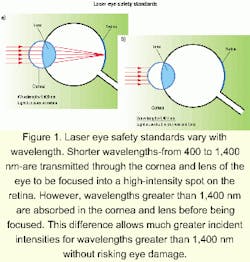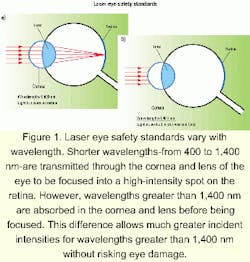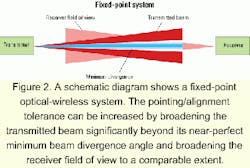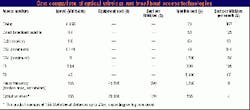Optical wireless: low-cost broadband optical access
Optical free-space wireless solutions provide fast, low-cost, high-bandwidth access for bridging the last mile.
DAVID ROCKWELL and G. STEPHEN MECHERLE, fSONA Communications Corp.
The global telecommunications network has seen massive expansion over the last few years, catalyzed by the telecommunications deregulation in 1996. First came the tremendous growth of the long-haul WAN, followed by a more recent emphasis on metropolitan-area networks (MANs). Meanwhile, LANs and Gigabit Ethernet ports are being deployed with a comparable growth rate. To exploit this tremendous capacity and provide users with the broad array of new services becoming available, network designers must provide a flexible and cost-effective means of accessing the telecom network. Currently, however, most local-loop connections are limited to a T1 line (1.5 Mbits/sec) and, as a consequence, there is a strong need for a high-bandwidth bridge between the LANs and MANs or WANs, known as "last mile" or "first mile."
Optical wireless systems represent one of the most promising approaches for addressing the emerging broadband access market and its "last mile" bottleneck. These robust systems, which establish communication links by transmitting laser beams directly through the atmosphere, have matured to the point where mass-produced models are now available. Optical wireless systems offer many features, principal among them being low startup and operational costs, rapid deployment, and high fiber-like bandwidths. Available systems offer capacities in the range of 100 Mbits/sec to 2.5 Gbits/sec and demonstration systems report data rates as high as 160 Gbits/sec.
To establish a metric for assessing the attractiveness of optical wireless, some ideal attributes of a generic broadband access approach must be considered. One of the most significant attributes is cost, which includes low installation cost as well as cost per bit associated with each subscriber. Low first-in cost, or the cost of launching access service for the first few subscribers, is also desirable.
The ideal broadband access approach should also offer rapid deployment to enable carriers to generate revenue as quickly as possible. Another important attribute is the capability to provide a high-bandwidth capacity to each subscriber, thereby enabling multiple services to be utilized. Moreover, this capacity should be easily scalable, not only in overall bandwidth, but also in the total number of subscribers using the access equipment. The ideal access approach should be available a high percentage of the time (up to 99.999% availability) and able to propagate data over relatively long distances.
Each broadband access approach offers a "zone of advantage." That is, each approach offers a more optimal performance for certain specific applications and deployment strategies. However, no single approach provides all the attributes listed here. For example, although dedicated fibers offer massive capacity, they are expensive and carriers miss many months of potential subscriber revenues while waiting for fibers to be deployed.
Fiber-based passive optical networks (PONs) represent a highly attractive approach due to the relatively low cost per subscriber. However, the inherent high capacity of fibers is shared among a number of users, thereby reducing the capacity per user. Also, deployment times can still be quite long, depending on the location of any particular subscriber. Radio-frequency (RF) fixed wireless systems are a credible access option but are limited in data rate, require Federal Communications Commission licensing, are subject to rain fading, and are costly relative to other access schemes.
The logical consequence of this situation is that one must select an approach that best meets the needs of a specific deployment. Optical wireless represents an approach with wide and broadly based applications appeal because of its many features. Optical wireless complements both RF and wireline networks, providing fiber-like capacity at data rates up to 2.5 Gbits/sec and more, with a cost per bit/sec that is among the lowest available-about $4 per Mbit/sec per month.
Given that no spectrum license is required, startup costs are significantly lower than for RF wireless. Optical wireless systems can be rapidly deployed. Once a suitable line of sight is identified, a point-to-point link typically can be installed and brought to operational status in approximately one hour or less. Well-engineered optical wireless links, which properly account for the statistical occurrence of fog, can achieve an availability of 99.9%, or even full carrier-class availability of 99.999% with a (lower-capacity) RF link or DSL backup. Finally, optical wireless systems are "network-friendly" in that they can be:
- Engineered to be protocol-independent.
- Implemented in cellular or mesh architectures as well as point-to-point links.
- Sent from roof-top to roof-top or through office windows.
- Designed to be compatible with common monitoring protocols to ensure the highest level of successful implementation.
- Redeployed to a different subscriber location if desired, for example, if an existing subscriber no longer requires an optical wireless connection due to receiving a direct fiber-optic connection.
Given these attributes, it becomes clear why optical wireless systems are being implemented in a broad range of applications and markets, including local-exchange carriers (LECs), Internet service providers (ISPs), network service integrators, and businesses ranging in size from small ISPs to major carriers and incumbent local-exchange carriers (ILECs). Market-analysis studies predict healthy growth of optical wireless systems, with annual growth rates in the range of 80% to 90% and projected total global sales of more than $2 billion in 2005.
Because cost is such an important factor in the broadband access market segment, a cost comparison of optical wireless and a number of established broadband access technologies are summarized in the Table. The final figure of merit defined for this comparison is cost per Mbit/sec per month. Optical wireless, at $4 per Mbit/sec per month, is half as expensive as the next lowest-cost alternative.
The most expensive technologies cost more than 80 times as much as optical wireless. This cost advantage arises from the combination of high fiber-like data rates and a low implementation cost. The cost advantage is so compelling that the individual numbers in the Table can vary somewhat without affecting the conclusion that optical wireless is the lowest-cost access approach. An even more compelling case for optical wireless cost-effectiveness applies for higher data rates of 622 Mbits/sec and up.
The engineering maturity of optical wireless is often underestimated, due to a misunderstanding of how long such systems have been under development. Historically, optical wireless was first demonstrated by Alexander Graham Bell in 1880. Nevertheless, essentially all the engineering for these systems was done over the past 40 years or so, mostly for defense applications. By addressing the principal engineering challenges, this aerospace/defense activity established a strong foundation on which today's commercial optical wireless systems are based.
First, these systems can be designed to be eye-safe, posing no danger to people who might happen to encounter the communications beam. Laser eye safety is classified by the International Electro technical Commission (IEC), which is the international standards body for all fields of electrotechnology. While the IEC is an advisory agency, its guidelines are adopted by the regulatory agencies in most of the world's countries.
A laser transmitter that is completely safe when viewed by the unaided eye is designated IEC Class 1M. In the United States, laser eye safety is controlled by the Center for Devices and Radiological Health (CDRH), a division of the Food and Drug Administration (FDA). Currently, the CDRH is in the process of adopting the safety classifications of the IEC.The collimated light beam entering the eye in this retinal-hazard wavelength region is concentrated by a factor of 100,000 times when it strikes the retina. Because the retina has no pain sensors, and the invisible light does not induce a blink reflex, the retina could be permanently damaged by some commercially available optical wireless products operating at 800 nm before the victim is aware that hazardous illumination has occurred.
In contrast, Figure 1b shows that laser beams at wavelengths greater than 1,400 nm are absorbed by the cornea and lens and do not focus on the retina. Because of these biophysical properties of the eye, wavelengths greater than 1,400 nm are allowed approximately 50 times greater intensities than wavelengths near 800 nm. This fact can be exploited by specifying a wavelength in the 1,550-nm range, where the factor of 50 additional laser power allows the system to propagate over longer distances and/or support higher data rates.
A second example of the engineering maturity of optical wireless systems is how well they address the challenges associated with fog. As is well known from common experience, fog substantially attenuates visible radiation, and it has a similar affect on the near-infrared wavelengths employed in optical wireless systems. Note that the effect of fog on optical wireless radiation is entirely analogous to the attenuation-and fades-suffered by RF wireless systems due to rainfall. Similar to the case of rain attenuation with RF wireless, fog attenuation is not a "show-stopper" for optical wireless because the optical link can be engineered such that, for a large fraction of the time, a sufficient power level will be received even in the presence of heavy fog.This important element of link engineering begins with the collection of fog-statistics data, which show what percentage of the time the fog attenuation will be greater than a certain value. Then, the fog statistics for the subscriber's location are used to determine how much fog attenuation (in dB/km) must be accommodated to guarantee a given value of availability, such as 99.9%. Next, the link design calculations are consulted to determine how much link margin is allocated to fog attenuation. Finally, the maximum link length is calculated according to the simple equation:
Length (km) = Link margin (dB) / fog attenuation (dB/km)
When this simple analysis is applied to actual deployments, locations having frequent and heavy fog will have shorter allowable links for a given availability. Alternatively, a relatively fog-free site might be able to accommodate link lengths of several kilometers using identical optical wireless equipment.
Optical wireless-based communication systems can be enhanced to yield even greater availabilities. In particular, by including an RF wireless link or DSL as a backup, one can offer availabilities of 99.999%.
Another example where practical engineering yields a reliable, low-cost optical wireless approach is the ability to maintain sufficiently accurate pointing stability without invoking the cost, complexity, and reliability issues associated with the use of an active pointing-stabilization approach. This preferred low-cost, fixed-pointed approach is schematically shown in Figure 2, where the transmitted beam is broadened significantly beyond its near-perfect minimum beam divergence angle, and the receiver field of view is broadened to a comparable extent.
The broadening of the transmitted beam and receiver field of view leads to large pointing/alignment tolerances and a very low probability of building motion being of sufficient magnitude to take the link down. Well-engineered hardware exploits this approach of designing for loose alignment tolerances. Therefore, it is possible to perform initial alignment of the transceivers at opposite ends of the link during installation, then leave them unattended for many years of reliable service. Note that this approach is facilitated for systems operating at wavelengths greater than 1,400 nm because the higher allowable eye-safe powers allow the transmitted beam to be significantly broadened spatially while still maintaining an adequate intensity at the receiver.
Other features of optical wireless systems that have accrued from the long engineering history include systems designed to allow simple, rapid installations (an hour or less), assuming a suitable line of sight has been identified already. Also, systems can feature scalability to multiple types of architectures, protocols, and higher data throughputs.
The final proof of the viability of any broadband access approach, including optical wireless, is the successful conclusion of rigorous field tests. In this context, it is appropriate to summarize some recent results that were achieved for a 0.5-km link near Vancouver, British Columbia. In October and November of last year, this link was operated 24 hours a day, seven days a week, for a total of 60 days.
Weather conditions varied widely during the tests and included periods of steady drizzle, heavy driving rain, and multiple occasions of moderate fog. The only time the link dropped out was a 20-minute period when fog reduced the visibility to about 50 m. These results demonstrate a total link availability of 99.97% in the Pacific Northwest, arguably a challenging climate for optical wireless.
Optical wireless represents a mature, reliable approach for broadband access. Such systems have been engineered to provide robust performance that is highly competitive with other access approaches, offering high capacity, excellent availability of 99.9% (99.999% with an RF wireless or DSL backup), lowest cost per bit per second, and rapid deployment in about one hour.
These systems are compatible with a wide range of applications and markets and sufficiently flexible for easy implementation using a variety of different architectures. Because of these features, market projections indicate healthy growth for optical wireless sales. This market potential will be met with well-engineered systems, designed for high-volume manufacturing, with immediate availability.
David Rockwell is director of advanced technology and G. Stephen Mecherle is chief technology officer at fSONA Com-munications Corp. (Richmond, British Columbia). They can be reached via the company's Website, www.fsona.com.



